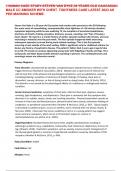I HUMAN CASE STUDY-STEVEN VAN DYKE,36 YEARS OLD CAUCASIAN
MALE CC:SMOKER WITH CHEST TIGHTNESS CASE LATEST 2023 AS
PER MARKING SCHEME.
Steven Van Dyke is a 36-year-old Caucasian male smoker who presents to the ED following
the acute onset of nonradiating, nonreproducible chest tightness of >20 minutes duration,
symptoms beginning while he was watching TV. He complains of associated palpitations,
shortness of breath, choking sensation, dizziness, nausea, sweating, and “fear of having a
heart attack.” He reports a 1-month history of similar episodes lasting 5-20 minutes, and now
increasing in intensity over the past week. The first episode happened while exercising;
subsequent episodes occurred during work-related meetings. This is the first episode
occurring at rest outside of the work setting. PMH is significant only for childhood asthma; he
denies any history of psychiatric disease. The patient’s father died 2 years ago at age 62 due
to an MI. PE reveals an anxious-appearing young male with fidgeting of hands and legs. He is
tachycardic and takes deep breaths between speaking in phrases. The cardiopulmonary and
neurologic exams are otherwise normal.
Primary Diagnosis:
Panic Disorder: characterized by episodic, unexpected panic attacks that occur without a clear
trigger (American Psychiatric Association, 2013). Attacks have a rapid onset of intense fear
with at least four of the physical and psychological symptoms, such as palpitations, sweating,
trembling/shaking, sensations of shortness of breath, feelings of choking, chest pain or
discomfort, nausea, dizziness, or fear of losing control or dying (Locke, Kirst, & Shultz, 2015).
The disorder is not caused by the physiological effects of a substance or undiagnosed medical
condition.
Acute Coronary Syndrome: symptoms of chest pain, referred chest pain, dyspnea, nausea,
vomiting, light-headedness, and diaphoresis. Chest pain is commonly the first symptom that
describes it as sudden, severe, heavy, and crushing sensation. Physical examination reveals an
increase in heart rate and blood pressure, abnormal extra heart sounds, pulmonary findings of
congestion, or peripheral vasoconstriction (Huether & McCance, 2012, p. 607). Typical angina
is described as substernal pain, occurs on exertion, and is relieved with rest (Achar, Kundu, &
Norcross, 2005). Chest pain that occurs suddenly at rest or in a young patient may suggest
acute coronary vasospasm, which occurs in Prinzmetal’s angina or cocaine or
methamphetamine use (Achar et al., 2005).
Hyperthyroidism: Elevated thyroid hormone levels amplify catecholamines resulting in
adrenergic symptoms (e.g., palpitations, tachycardia, heat intolerance, diaphoresis, tremor, lid
lag,) (Kravets, 2016). Psychiatric symptoms, such as anxiety, may be present. Enlargement of
the thyroid gland (goiter) is common in hyperthyroid conditions caused by stimulation of TSH
receptors (Huether & McCance, 2012, p. 454).
Status/Condition: Stable
Code Status: Full
Allergies: None




